If you are here from our latest YouTube video, please read and scroll to the bottom for contact and details regarding the sail of our beloved Avocet.
The Discovery and Details of our Cheoy Lee 41′
The Discovery
Back when Chris and I were looking for boats in 2018, our Cheoy Lee 41′, Avocet, was not even on our radar. In fact, a boat of her caliber was out of the question entirely as we were looking for something more quaint and simple like a Catalina 36. At the time, we had no intentions of cruising and were looking for a crash pad to lay our heads at night while Chris finished his studies at film school in San Francisco Bay. We searched high and low for the perfect boat, and convinced ourselves the Catalina 36 was everything we wanted… until we actually stepped aboard one in Southern California, and realized that it wouldn’t suit our lifestyle needs. Having spent the better half of the month convincing ourselves it would be the boat for us then driving from North Lake Tahoe to Oxnard – 11 hours – to see the boat in person just to realize it wasn’t for us had us absolutely devastated and without any real plan B’s lined up. Fortunately, we had Chris’s brother Jon with us who was quick to search the area for other boats to look at – even if we had no intentions of buying them. And that is how we met Avocet.
“We cruised with a boat like this in Mexico,” Jon shared as he boarded the boat. The broker had finished explaining that they had just listed the vessel with their office that week, and they didn’t anticipate it staying around for long. After a few moments on board, we could definitely see why. Chris felt right at home, comparing the warm teak walls to his family’s Mason 43’ that he grew up sailing in the bay. I was not charmed as easily, mostly due to her interior being unlike any other I had ever seen, and to my own faults I wrote it off as atrocious instead of unique. “Just… give it a minute” Chris begged, as he invited me to partake in his daydream where he shared all of his ideas on how he could make the boat “home”. Although he won me over in the end with his big picture planning, it didn’t excuse the fact that the boat was a bluewater cruiser and we had been looking at “plastic fantastics” that were in our humble fresh-out-of-college budget. Alas, with little hope we thanked the broker for taking the time to show the boat and began our 11 hour drive back home to Tahoe.
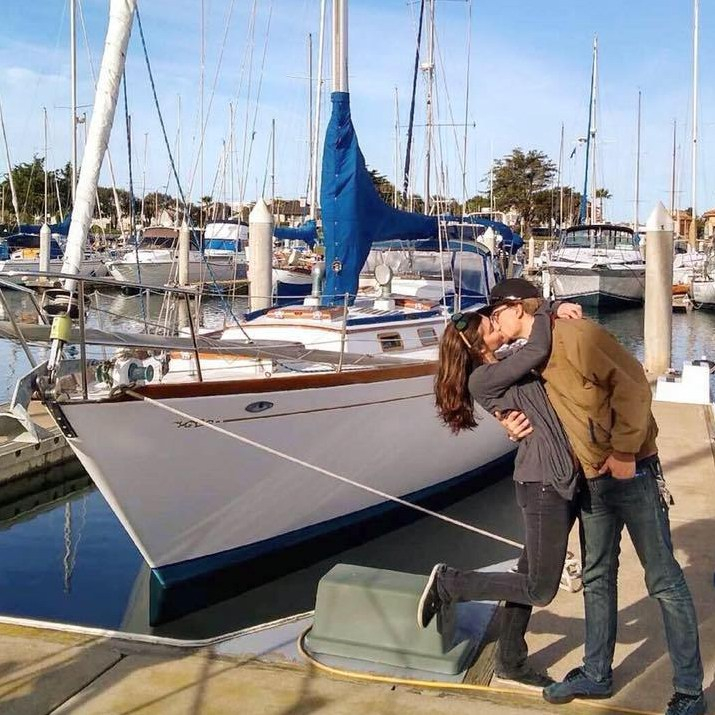
When two 20 year old kids decided to buy a boat
Chris couldn’t stop thinking about the boat. He was caught by her spell and on a whim sent an offer to the seller. It was laughable at best, probably somewhere around $25,000, which is what we had saved for a completely different type of boat. Of course, they rejected the initial offer but Chris couldn’t let it go. He wrote a letter to the seller, explaining who we were, why “we” loved the boat so much and would be honored to have the opportunity to buy it. Because of that letter, the seller worked with us directly to find an agreeable price which came out to around $30,000 ($10,000 less than the original listed price) – we still had to pull some strings and get a bank loan, but we got the funds and signed the papers making Avocet officially ours.
The Legacy
Those first few months on Avocet were grueling. Although she was in relatively good shape, she had been a liveaboard vessel for 20+ years and heavily cruised by her prior crew. As we cleaned up, moved aboard and ripped into our first projects, we uncovered parts of Previous Owners (PO’s) life such as his undoubtable habit of dropping knives on the galley floor and putting line away wet. Surely, PO moved off the boat in haste, leaving many odds and ends behind from food (that now had maggots) to personal items. We quickly learned why. Inside the nav desk next to some carefully annotated charts we found a folder with photos of PO and his wife sailing through Mexico, with chemo bags hanging from the bimini. We reached out to the primary seller, who was PO’s daughter, who sadly explained that her father had just passed away shortly after we signed the papers. He was an avid sailor, and loved this boat with all his heart, which is why we decided to keep sailing under the name Avocet and continue the legacy he had started. Thanks to social media and the power of the internet, a lot of Avocet’s previous crew members have slid into our inbox to share stories of their time aboard and help answer the questions we had. One crew member in particular was a best friend of PO and sent us this wonderful email:
* [PO and his wife] the second owners. I don’t know the history before they bought her. [PO’s wife] and my wife were avid bird watchers… we named our first boat, “Waxwing” and [PO’s wife] liked, “Avocet”. Her favorite shore bird. We had a small painting commissioned for them of an Avocet (see pic). We didn’t anticipate that the perspective would make the bird look the size of Godzilla (We called it the Avocet that ate Cleveland). It fell to me to clean out Avocet, and get her listed to sell. I took the Avocet painting, which hangs in my music room. [PO] never used the engine to go in or out of the slip. He did a great deal of single handing of “AVO” after his wife passed away in 2013. Rigged a light line, lead to the dock that helped insure that AVO would point the right way after blowing downwind from the slip. He was an expert at it. Just as an aside, [PO] was a navigation instructor for awhile… They lived aboard her from the early 80s in Redondo Beach. Then he moved AVO to Ventura Isle Marina.
*PO and senders name redacted for the privacy reasons

From then on her legacy lied with us. But first… projects.
The Confusion (What is She?)
People recognize that Avocet is a Cheoy Lee, but often fail to identify her model. On the outside, she looks strikingly similar to the Offshore 41 and even the Pedrick 41 designs, but has key differences that set her apart from both – so why the confusion? Well, back in the day Cheoy Lee did something a little shady and “borrowed” a design from Naval Architect Ray Richards, the designer of the Offshore, and changed it ever so slightly to avoid paying royalties, calling their design a CL41. Richards was the first architect to design a fiberglass hull that met Lloyd’s construction standards, combining both style and performance. The new-at-the-time radical design of her keel was a 6′ deep cruising fin in which the forefoot is a cutaway and the rudder is attached to a skeg. The boat was described by Richards as being “stiff as a church” which we have found to be very true.
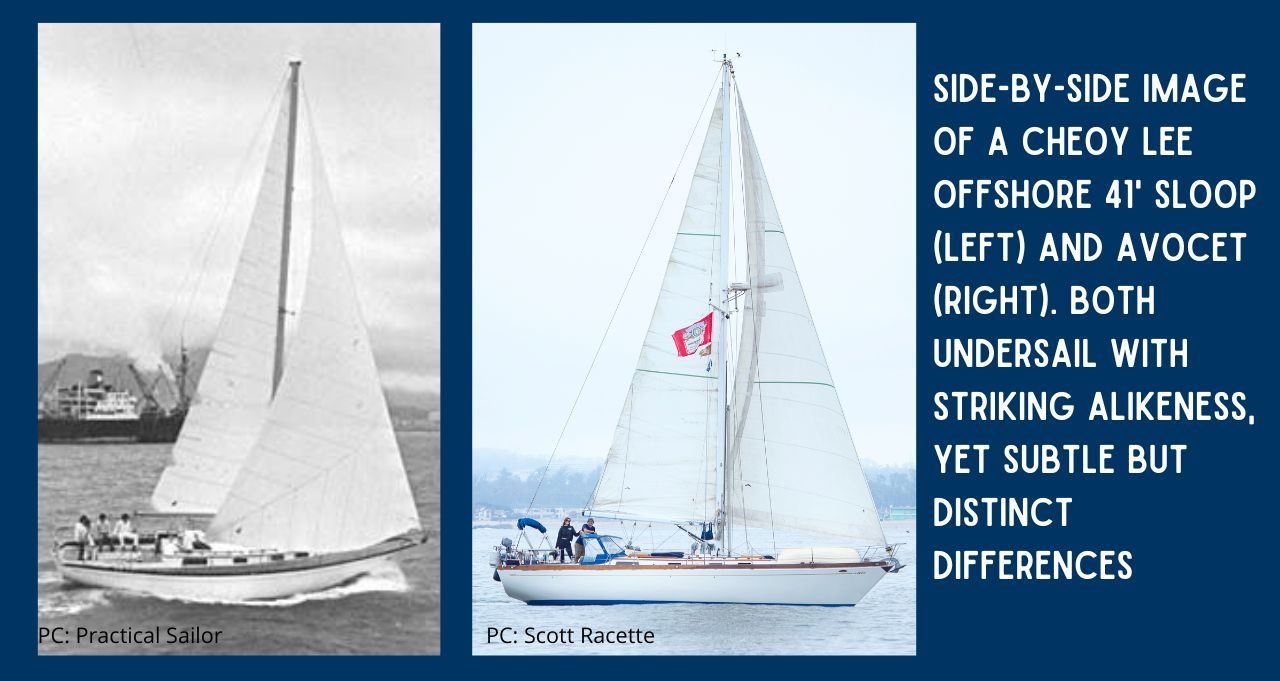
Unlike Avocet, the Offshore 41’s don’t share the same tumblehome, leaving them much narrower with a different sheer. Inside, the saloon is oval shaped unlike the very semi-circle cut of the Offshore, and the head is aft of the saloon on the starboard side in front of the stateroom with a closet separating the two spaces, whereas in the Offshore there is no closet but instead a door to the head so you have access from the stateroom. Additionally, underneath the waterline Avocet is very different in comparison to the Offshore, due to her modified fin keep and separated skeg hung rudder. Because of this, our prop shaft comes right out of the keel (aka the deadwood) making our shaft 4.5’ long unlike the Offshore and Pedrick designs. Another notable difference is that the Offshore has a slightly taller cabin top.
- Cheoy Lee 41′ Schematic
- Offshore 41′ Schematic
Unfortunately, there is not much existing literature on CL41’s – especially sloops – since they seemed to have been built to order, and highly customized by whoever commissioned them – meaning Avocet is truly one of a kind. Despite being one of the oldest shipyards in existence, Cheoy Lee was unable to assist in our hunt to find details on Avocet in particular, showing no records of her in their database. Regardless, they have been more than helpful in answering our questions on their design ethos from “back in the day”. Ray Richards himself was also kind enough to answer my emails in regards to our design and provided some insight, supporting the finds of our deep research:
“I am not particularly familiar with it, but your email jogged my memory that indeed, Cheoy Lee had Pedrick design a 41, “borrowing” from mine but with the, by then, contemporary style of underbody and flatter sheer. I also recall that Pedrick was or had been in the Sparkman & Stevens office, a factor that Cheoy Lee probably and understandably would have figured as good for sales. There were more than a few misquotes and errors. For example, I turned out 4, not 10 designs for Cheoy Lee. The first was a 39, a larger and heavier version of an aluminum one tonner that had received some good press, but it was totally away from the type and style of CL’s market niche. It was flush decked and had a plumb transom from which a dirty big outboard rudder was hung. Tad Woodhull, Lyon Yachts, Essex, Connecticut, had one and did well racing it in Long Island Sound. It was he who stimulated Cheoy Lee toward replacing Phil Rhodes’ very handsome RELIANT, which came to be sold as their OFFSHORE 40. Thus came my 41, which was originally designated OFFSHORE 40. Maybe that, in CL’s mind, was much like replacing a Richards with a Pedrick. The 32 came next. It was followed by the 38, very similar in features to the 41. “
There only seems to be eight CL41’s in existence, which is reflected on the Cheoy Lee Association owners page, and Avocet appears to be one of the only sloops.
The Construction
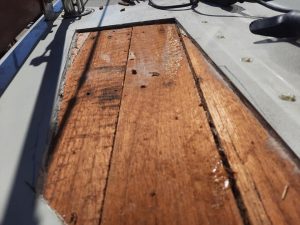
Inside our deck
Like most boats of this vintage, Avocet has a solid fiberglass hull. According to the company literature that we could find, the thicknesses in these boats ranges from about 7/16” at the sheer to 1” but we have found Avocet to be 5/8ths at the sheer and 1.5” – 2” at the keel. This level of fiberglass production was uncommon at the time, and definitely gave Cheoy Lee a good reputation for building brick shithouse boats. Unlike a number of other early fiberglass classics the Cheoy Lee 41’s had fiberglass decks, most with a teak overlay. Avocet’s teak deck was removed by PO most likely at some point in Mexico in 2004, from the receipts and various papers we have found in the boat. Beneath the fiberglass deck is mahogany planking that serves as core, which we inspected and pleasantly found to be dry as a bone.
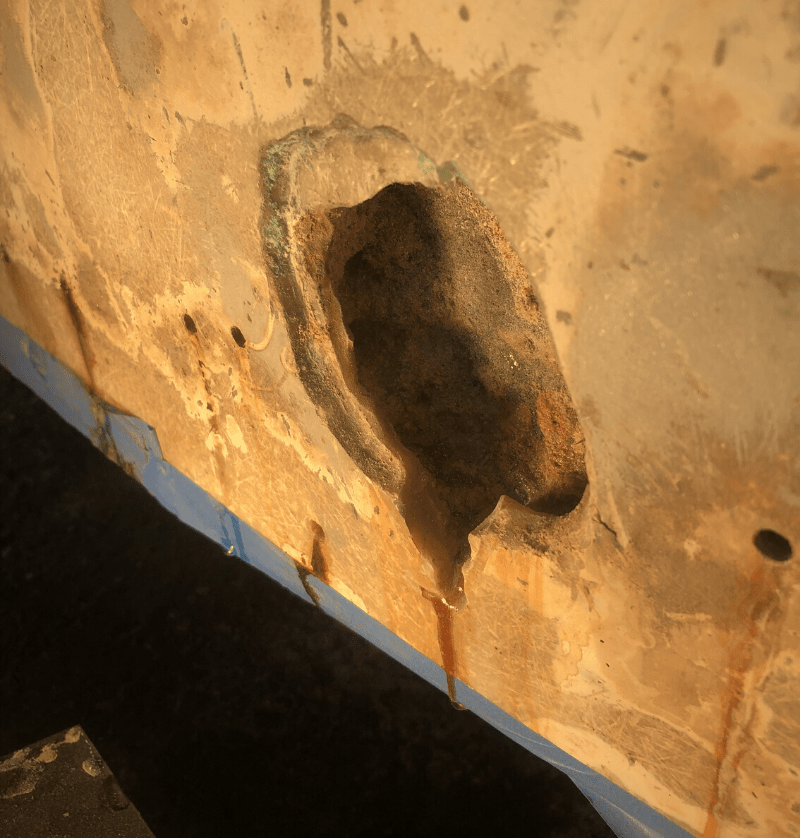
Remember this monstrosity from our haul out in 2020? Yah… its how we confirmed we have lead. *silver linings*
Although Cheoy Lee notably poured their own cast iron ballasts, we found our keel to be lead which is preferable as it is denser, softer, and not subject to the corrosion that iron is. We cross referenced our discovery with Cheoy Lee Shipyards who said it was unlikely we had a lead keel, but after confirming our findings with the boatyard, our surveyor friend, and other pals in the industry we confirmed that we were dealing with lead – especially after our magnet refused to pull to it which, with iron, it would have since it is a ferromagnetic element. It is very possible that Avocet’s original owner commissioned her to be built with lead ballast, which we are very thankful for.
Speaking of metal, Cheoy Lee was infamous for using poor quality stainless steel from the chainplates (which crumbled in our hands) to the fasteners. Fortunately, since these boats are 40+ years old most of the owners like ourselves have done their due diligence and replaced the shoddy metal, a definitive low point of the vessel’s construction. However, at the time of replacing the metal it is very likely that it already paved the way for a cascade of other problems such as leaks that lead to wood rot. We had this issue when the fasteners in our toe rail galvanically corroded, leaving voids that allowed water intrusion into our interior. Instead of replacing the toe rail, we removed it entirely and implemented a bulwark design which would forgo the need to install 180 through bolts back into the deck. The bulwark design allowed us to glass over the deck to hull joint, reinforcing the structural integrity of our boat and has continued to be the crowning upgrade on our extensive project list.
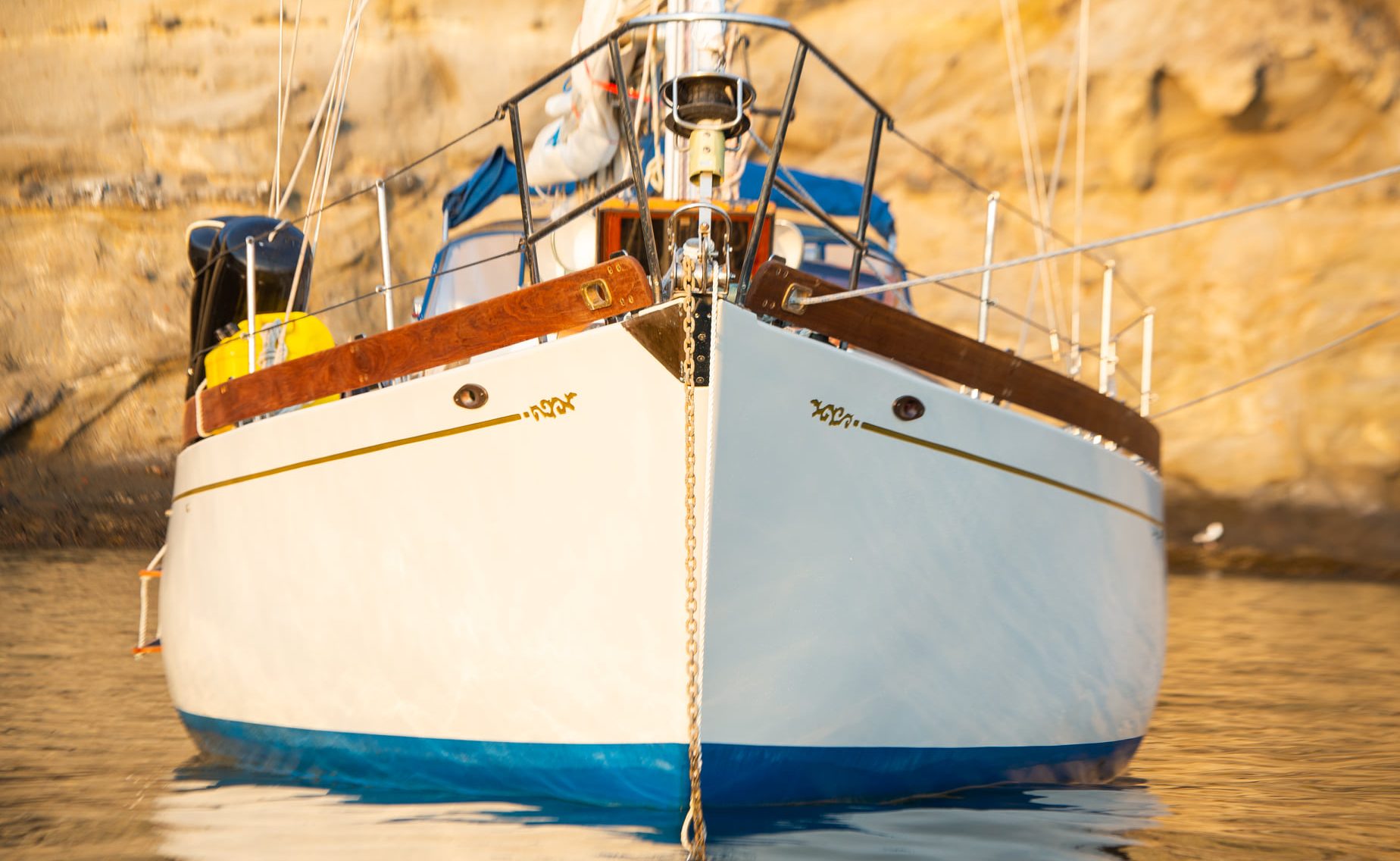
Like the teak decks, PO replaced the Sitka Spruce Spar sometime in 2004 with our aluminum mast that we recently refit in 2021. Avocet is deck stepped with a single spreader, with a relatively short boom which means she is heavily headsail driven. I know what you are thinking – a cruising boat with a deck stepped mast? How could this be?! Well, like many things in sailing, there are two schools of thought when it comes to the deck stepped vs. keel stepped debate, but let’s focus on the facts: Deck Stepped boats have masts that are more flexible which means that the mast is easier to adjust for optimum performance by making small adjustments to the standing rigging. Going upwind, the backstay, runners, and check stays can have tension added to them to tighten the stays and pull the mast aft. This will both rake the mast aft giving it weather helm as well as tension the headstay for added pointing ability.
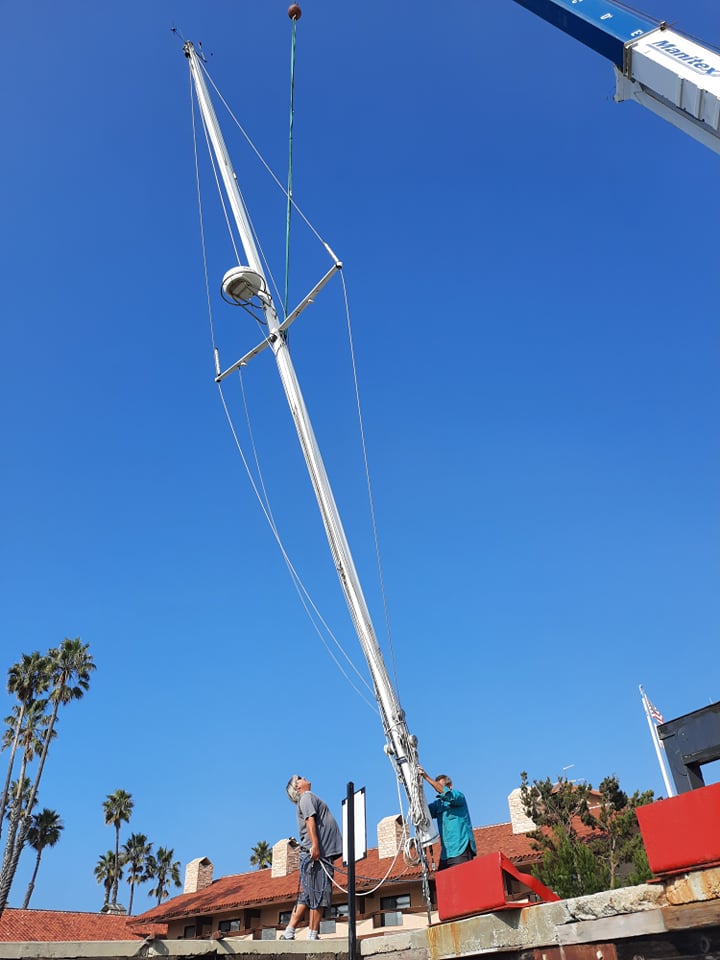
Pulling the stick out back in 2021
If all the stays fail on the mast (god forbid) then the mast will fall over! On a Deck Stepped mast, this means that the mast will just fall over since the mast stands on the deck totally reliant on the rigging – one of the many reasons we decided to replace our chainplates, all the rigging and beef up our mast step in 2021. For more insight on the mast vs keel step debate, we recommend you read this post by the Rigging Doctor.
Avocet’s geared steering quadrant is very unique. Unlike cable steering or worm steering, the input from the helm goes directly to a pinion gear which turns a larger planetary gear which then turns a drive shaft which is mounted vertically inside the binnacle. This then connects directly to the rudder shaft through two more gears. What all this means is there is very little to go wrong with this system. All the gears are locked together with very large components taking the risk of cable out of the equation entirely.
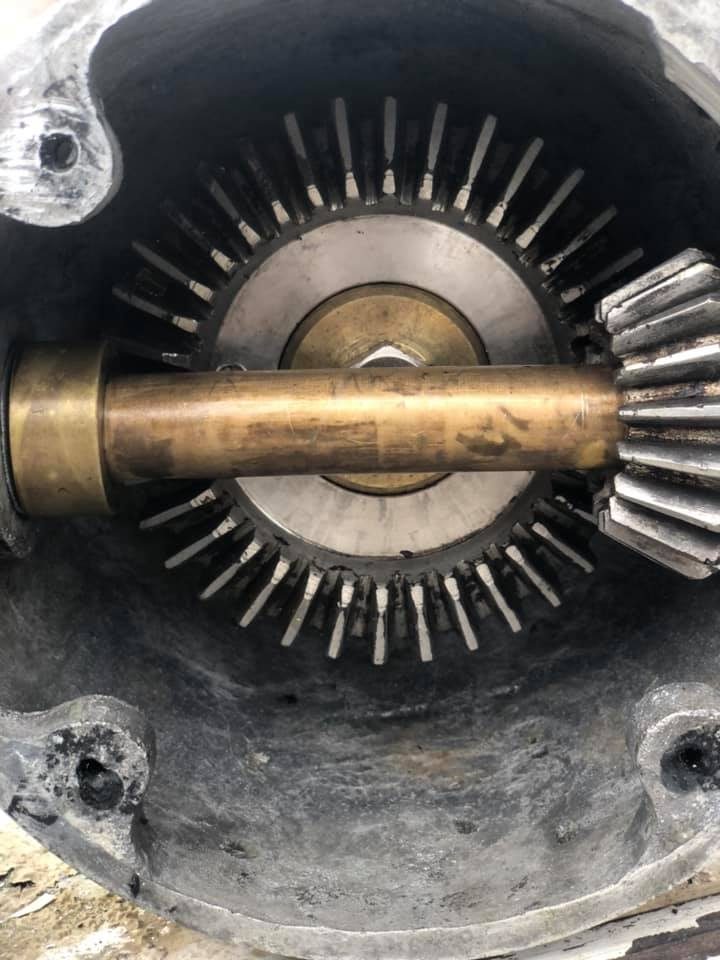
Inside the binnacle
With so much mechanical advantage, Avocet has a different “feel” when compared to other boats. Because of her unique geared steering, we can never feel wetherhelm which takes some getting used to if you are a seasoned sailor with experience on any other boat. However, this also means that we have an easy time hand steering and gives our autopilot more control. The lock to lock (full port to full starboard) takes 4 complete revolutions of the helm, which is also unique and worth mentioning which again, takes a little getting used to, but in the time we have owned Avocet we have really grown to like this system.
In addition to her sails, Avocet has an inboard Perkins 4-108 diesel engine that lives midship between the galley and the head. By keeping the weight concentrated to centerline, it lessens the bow-stern pitching moments which we have found to be true, but we will get to that in the performance bit of this post. As mentioned keeping the engine centerline is very important but what is more important is keeping the weight low. In Avocet the Perkins engine is mounted below the cabin sole, which is about two feet below the waterline. Some will say that this is negative because it can get dirty fast, is not the easiest to work, and (arguably) would flood first but by having the 600 lbs of weight centerline and as low as possible it becomes a valuable addition to our lead ballast making it the best possible location for sailing performance. You see this incorporated into designs like Al Masons Mason 43, another blue water cruising yacht. To remedy the negatives, all of our cabin sole is removable which helps us access the engine, and by having a 6’ deep bilge with ample pumps and alarms we would have time on our side to assess any incoming water to eliminate flooding. On the flip side, if our engine was located above the cabin sole and beneath the companion way (like many are) it would be at equal risk of getting water damage due to a green wave – a very good reason why we relocated our batteries from that location to one that was watertight and out of the direct path of any unforeseen incoming water.
View this post on Instagram
Above Photo: Before we rewired, cleaned the bilge, and did a bunch of other projects. Cleo’s face says it all.
Speaking of water, our water and fuel tanks are made of fiberglass which have a lot of cool benefits. Our tanks are integral and use the hull as part of the tank structure itself, maximizing volume with minimal impact unlike traditional tanks which sit inside a cavity that inherently takes up space. “But what if you puncture the hull and it goes in your tank?” Great question, I wondered the same thing when we were first looking at the boat. Neptune forbid something like that should happen, but if it did the sea water would fill the tank and stop there. We have two water tanks; one located on each side of the boat under the settees, so if we lost one tank we would still have another to rely on until the problem can be remedied.
The diesel tank lies under our salon table and sits right on top of our ballast. Upon inspection we were surprised to learn that the bottom of the tank was flat rather than “v” shaped which we had assumed since it would follow the natural shape of the boat. Having a flat tank bottom is great since it is easier to clean and the pick up tube for the engine isn’t as susceptible to clogging as it would be if it were a V shape. If it was a V shaped bottom, sludge would accumulate at the lowest point and could clog the pick up tube all at once like a big nasty plug, leading to many issues.
One last major benefit to support fiberglass tanks is their ability to be repaired indefinitely, and in place. Black iron tanks, which many boats from our era were fitted with, need to be cut out and removed which is usually a very intrusive job – especially since so many builders decided to build around the tanks leading future owners to have to cut away cabin sole, cabinets and more in order to get the job done.
Avocet’s all teak interior is what initially won Chris over, and was a major selling point for choosing an Asian boat in the first place. An old brochure calls it a “lavish teak interior” which we are inclined to agree with. Many boats of this era were finished with old growth teak, which is gorgeous but requires a lot of upkeep. Due to overharvesting and mismanagement in the past, it is very hard to find a newer boat that displays the same level of teak craftsmanship- which is one of the reasons it has started to go out of style. Nowadays it is more common to see new boats sport the easy-to-clean-and-care-for Ikea look, ringing true for the old saying “they don’t build them like they used to”
View this post on Instagram
Avocet features an aft stateroom (where we lay our heads at night) a V berth that can snuggly fit two, a quarter berth that can fit two and each settee in the salon has lee cloths to hold in any additional crew members that find themselves sleeping there. Comfortably, Avocet can sleep five adults while overall she could accommodate about eight… but let’s keep in mind she only has one head! Although designed as a wet head, Chris and I made modifications for a quasi shower stall that better suited our needs. The galley is what really won me over with wide counter space, a deep sink (that we made deeper) and a (relatively) large boat fridge and freezer that our other boat friends have been known to “rent” from time to time so they could also enjoy ice cream as well. The salon table is perfect for hosting large dinners or game nights, seating up to eight but we have definitely squished more!
Performance
Although Avocet isn’t truly an International Offshore Rule (IOR) classified vessel, she shares a lot of traits having been built at the height of IOR times in the late 70’s. Her hull features both bow and stern overhangs, a wide beam, and she is heavily headsail driven. She sails incredibly well for her heavy weight and beamy nature. With a modified fin keel and a large rudder far back on the stern, Avocet always feels well footed while underway. Avocet’s keel digs in deep to the sea while her rudder always has a significant amount of control on any given point of sail.
At 26,000 pounds Avocet is not a light boat, but she carries the weight in all the right places. By far, our favorite attribute of Avocet’s design is her low slung nature. This means her freeboard is relatively low off the water and much of her weight is carried below the waterline. This all contributes to Avocet’s best sailing characteristic which is her stiffness. On a generous breeze of 15-25 kts we can carry all our canvas and keep a heel no more than 15-20 degrees – which makes for life aboard while underway blissfully comfortable.
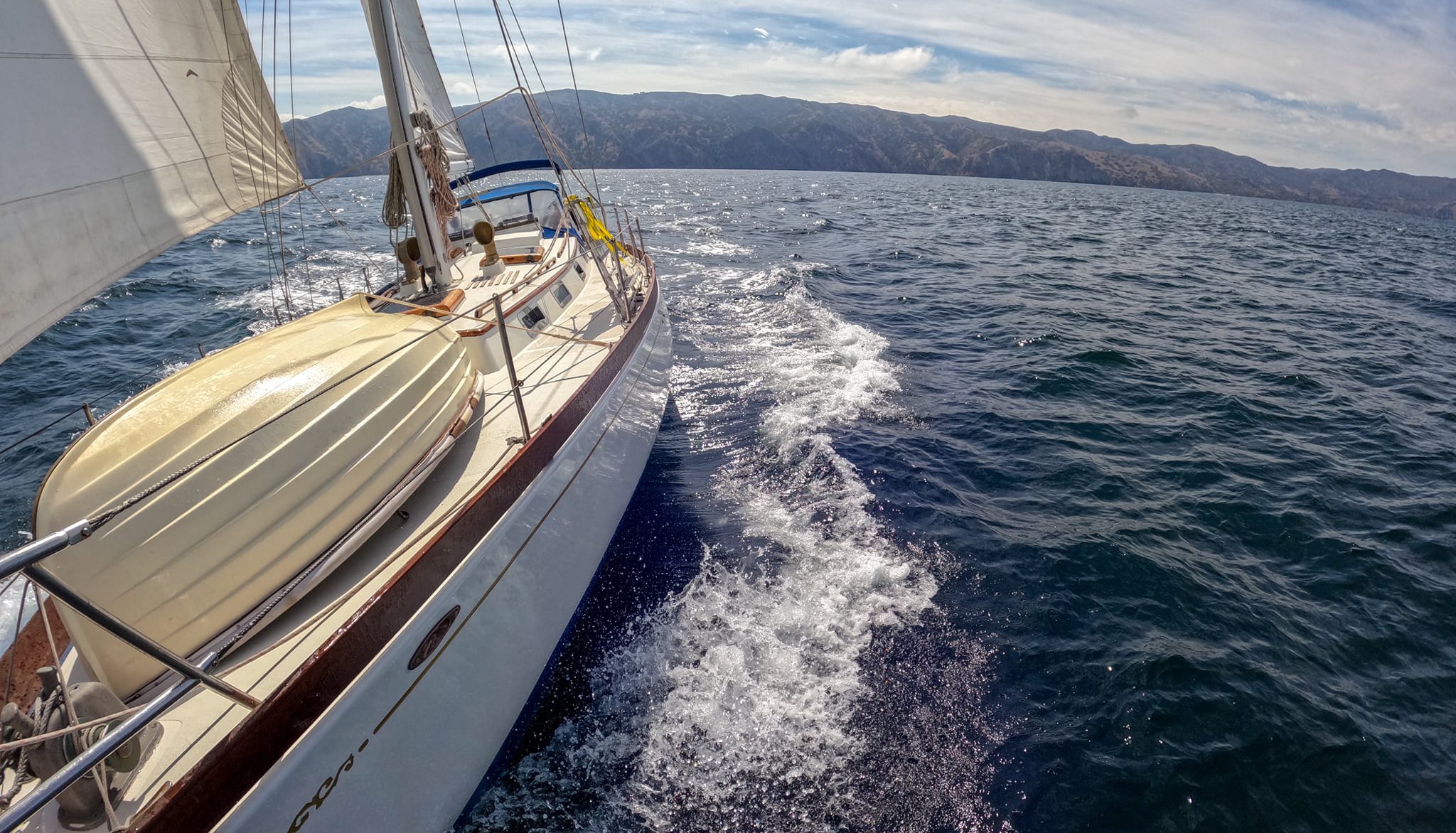
Final Thoughts:
Like any smitten crew, we could talk about our boat all day and love to answer questions about her. At the time of writing this we are entering our fifth year of ownership and have never felt more at home as we do aboard Avocet. She has continued to take good care of us, and we promise to continue taking good care of her. Although we are unsure what ports Avocet’s sister ships call home, if you are in the market for a Blue Water cruiser and come across a bonafide CL 41 we are confident that you will not be disappointed. They are solid, balanced, nimble to sail, and with their well-designed and intentionally thought out beautiful interior, you (like us) may aim to never come ashore.
If you would like to learn more about Avocet and her specifications feel free to email us at sailingavocet@gmail.com… Full spec “about” page coming soon!
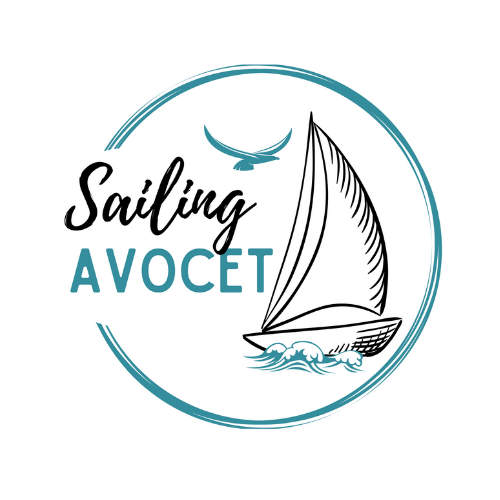
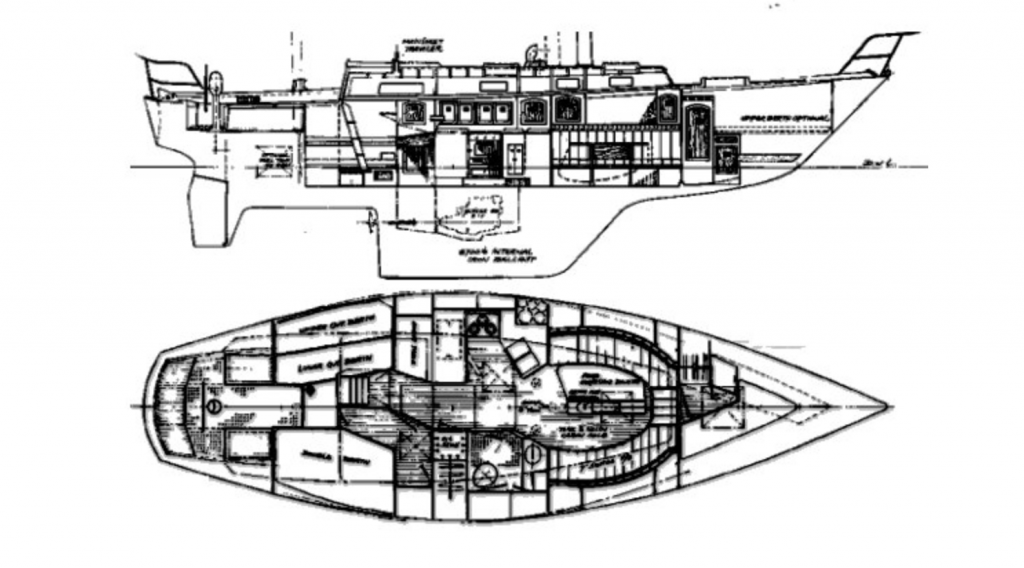
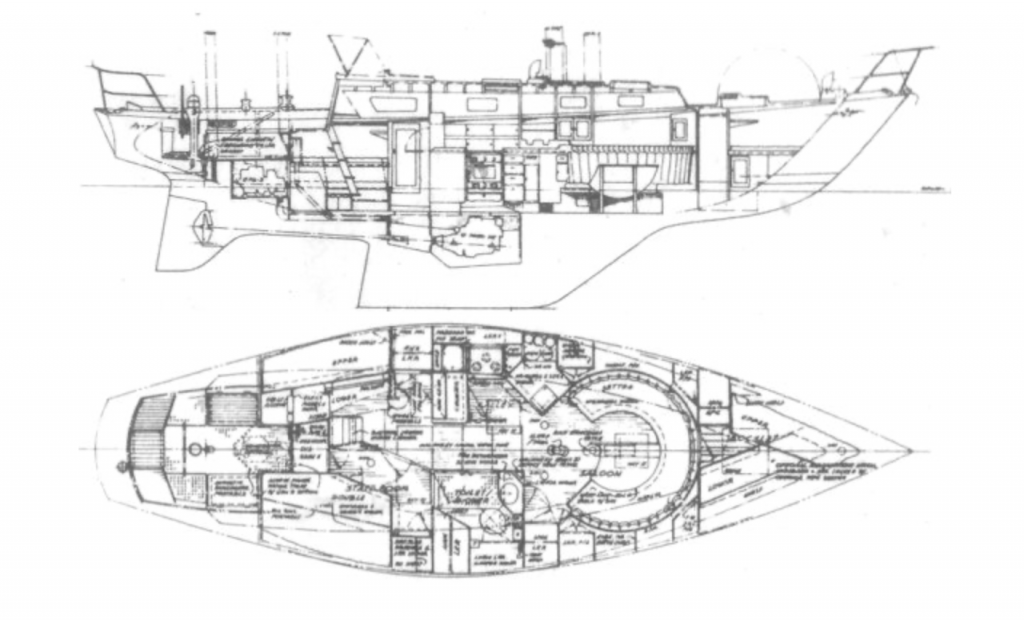


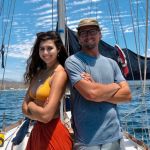

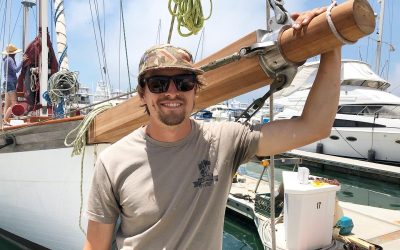
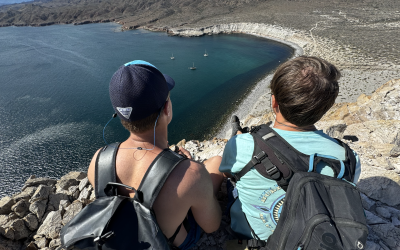
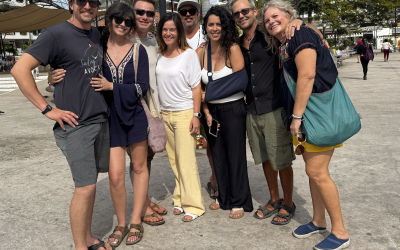
My wife and I did a 12 year, 44,000nm circumnavigation aboard our CL 41, Virgos Child. We were very happy with her performance in all types of conditions we encountered. We can relate to the issues you raised as we replaced chain plates etc and did a major refit , replacing the teak deck and replacing the Isuzu 3 AB 1 engine with Beta 40 hp. After 18 years of ownership and living aboard we sold her.. She was sloop rigged which I changed to cutter for better performance. Aluminium mast and boom and single spreader rig and 10 mm ss wire and stay lock fittings. All in all a great boat that served us well.
Sincerely hope you have as much fun and adventure as we did.
Terry and Elaine
Hey Terry and Elaine! I recognize your boat name from the CL association page website – or perhaps we have chatted in the past. Funny enough, Avocet was rigged as a “slutter” when we got het but removed her solant stay since it is where our dinghy goes on deck. Im sure she would be hard to catch with a cutter set up! Thank you for reading, reaching out and sending us well wishes. We look forward to sharing more stories soon. Fair winds!
I remember the previous owners, John and Robin. They had the boat in the slip behind us in King Harbor for many years. At the time, we had a Cal 39 sailboat. John moved the boat after Robin passed away. Very nice people. It is true they never used the engine to come in and out of the slip, they sailed it. Most of the time they didn’t hit anything, sometimes they did, but nothing major. My wife and I are very happy that someone bought the boat and is putting it to good use.
We love getting messages like this! It sounds like John and Robin were wonderful people, and we are so happy to continue their legacy. Thank you for reading and reaching out! How did you happen to stumble upon us?